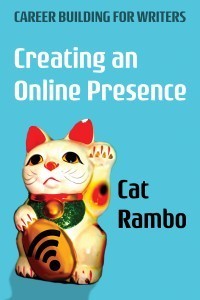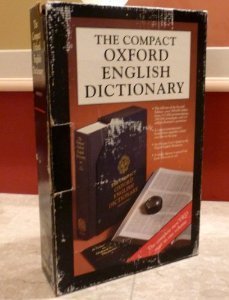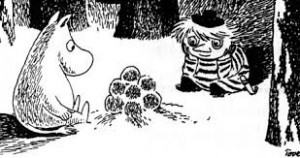Cat Rambo's Blog, page 61
March 23, 2014
Creating An Online Presence Now Available for More E-formats
Now you can find Creating an Online Presence on Smashwords as well as Amazon. The book covers the basics of creating and maintaining a presence on the Internet for writers. Here's a coupon for 50% off on the Smashwords version, good through 4/22. BH28S
Huzzah! Thanks to the patient labor of Tamara Vining, there’s now plenty of options up on Smashwords, including epub, mobi, pdf and online.If you’re not familiar with the book, it’s based on my online class, and tries to go through basics of creating and maintaining an online presence for writers.
It includes what you need on a website, how to effectively use social media, how to find readers via social media, what free resources and tools are available to writers (and how to use them most effectively), whether it’s worth it to pay for online advertising, and, most importantly, how to promote yourself online without using all your valuable writing time to do so. Because the writing always comes first.
If you’ve read the book, please recommend it to other writers and/or leave a review somewhere. Here’s the Amazon page.
March 14, 2014
You Should Read This: An Appreciation of Andre Norton
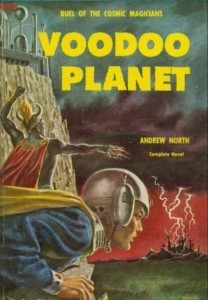 My high school years were steeped in reading from several F&SF authors. Among them, the most influential was quite probably Andre Norton. In arranging my book collection in those early days, Norton was always satisfying, because she wrote a gazillion books and I had most of them. In fact, I know three fantasy landscapes well because I wandered them so often as a young reader: Narnia, Middle Earth, and Norton’s Witch World.
My high school years were steeped in reading from several F&SF authors. Among them, the most influential was quite probably Andre Norton. In arranging my book collection in those early days, Norton was always satisfying, because she wrote a gazillion books and I had most of them. In fact, I know three fantasy landscapes well because I wandered them so often as a young reader: Narnia, Middle Earth, and Norton’s Witch World.
The book I’m working on right now, (working title CIRCUS IN THE BLOODWARM RAIN) tries to get at the feel of some of those books: a protagonist moving across a mysterious landscape laden with both treasures and perils from the past, along the lines of Breed to Come, Forerunner Foray, or Star Man’s Son, 2250 A.D.
Norton, the first female SFWA Grand Master, wrote both fantasy and science fiction, both awesome, but I have a particular fondness for her science fiction, like Moon of Three Rings, Judgement on Janus, and Sargasso of Space. Her Free Traders have a gritty feel that predates many other works with a similar feel, like Star Wars or C.J. Cherryh’s Chanur series.
The problem with talking about Norton is that she’s both prolific and consistent, making it hard to find stand-out books to recommend. So here, rather than a single book out of her 314 titles, are several possible entrances into her work.
The Witch World series: Like a lot of Norton’s works, this hovers somewhere between science fiction and fantasy, but ends up sliding pretty firmly into fantasy. There are predecessors, long gone, who have left behind objects of great peril and power, and rival factions with differing degrees of what is either magic or technology that amplifies psychic powers. Technically, the series should start with Witch World, where Simon Tregarth of Earth finds himself transported to that world, but my own suggestion would be to back into the series the way I did, starting with Year of the Unicorn and its sequel, The Jargoon Pard, (the overall series is made up of a number of sub-ones) which will give you the flavor of the world before explanations begin.
The Solar Queen series: The Solar Queen is the name of a Free Trader spaceship. these are early Norton, many originally written as Andrew North. Look to the earliest ones — Sargasso of Space, Alice Mary Norton, and deeply regret never meeting you. You’re one of the people that shaped my writing, and you did that to a significant degree. Here’s to your stories, and all the readers who will find them in the centuries (or so I hope) to come.
March 13, 2014
You Should Read This: The Past Through Tomorrow by Robert A. Heinlein
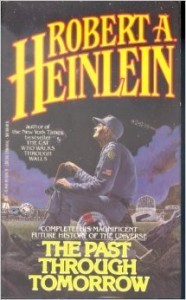 A blog post I read recently used attitude towards Robert A. Heinlein as a measurement of a person’s…I’m not quite sure what, but it seemed to be connected to their worthiness to be part of the F&SF community.
A blog post I read recently used attitude towards Robert A. Heinlein as a measurement of a person’s…I’m not quite sure what, but it seemed to be connected to their worthiness to be part of the F&SF community.
I don’t care so much about that. There are problematic aspects to Heinlein’s writing, yes, and one fascinating thing about that is that they span the range of the political spectrum. But regardless of attitude, if you want to be well-read in science fiction (by which I mean you have read much of the significant material in the field and understand at a rudimentary level where it fits in relationship to other significant works), you need to have at least a nodding acquaintance with Heinlein. And if you are looking for one work that shows his range and also includes some stories that show how marvelous a wordsmith he can be, I recommend The Past Through Tomorrow: Future History Stories.
Why do you need to have read Heinlein?
Because a significant group of readers came to science fiction through Heinlein’s YA novels. Know the novels and you’ll have a better understanding of some of their sweet spots as well as many of the basics for writing a YA novel. Heinlein knew how to do it.
Because he wrote so many landmarks in the field. Decades later, they’re still using the word “grok” (from Heinlein’s Stranger in a Strange Land) at Microsoft. The Moon is a Harsh Mistress and Starship Troopers are other books that are worth grabbing if you only read a few of his books.
Because he influenced so many other writers and also interacted with and mentored many of them. Read his letters to get a sense of those interactions.
Because he is problematic. Farnham’s Freehold is infamous for how badly it’s aged and how racist it appears today, and in some ways it showcases how a writer can fail (in my opinion) to rise above the limitations of their own world view. If you want to avoid similar traps, you need to understand where Heinlein fell into them. Heinlein has some books that I recently saw described as “squicky” and I will agree that featuring an incestuous relationship with underaged twin girls, for example, in a book does strike me as squicky — (although I didn’t note it at all when reading the book as a teen). Lolita‘s squicky too. But it’s still literature. I don’t think anyone should be shamed or scolded* for having read Heinlein or even liking his work. I like a lot of his books.
To go back to the idea of using this as a measurement of who belongs in fandom and who doesn’t: this assumption is asinine. It’s a straw man argument. If you read and enjoy science fiction, you are a part of science fiction fandom regardless of what is and isn’t your favorite. And to present this as a characteristic of some monolithic block in fandom (or use it as a way to place them outside “true” fandom) strikes me as a misguided strategy if one is genuinely trying to solve divides causing difficulties in communication.
But I digress, and in doing so I’m pulling you away from some writing that has always moved and impressed me. The story, “The Green Hills of Earth,” for instance, makes me weep and sticks with me to this day. “The Man Who Sold the Moon” is another classic, with a protagonist who is one of my personal favorites. Beyond that, the book provides a sense of the chronology of Heinlein’s universe and the events that shaped it, functioning as a sampler of of his stories.
And it holds “The Menace From Earth,” a story that so irritated me that decades later it spurred my reply, Long Enough and Just So Long.
So yeah. You should read a little Heinlein. And you should read other stuff too, newer stuff. Stuff that grew out of his works, like Bill the Galactic Hero, which was Harry Harrison’s reply to Starship Troopers, or Soldier, Ask Not, which was Gordon Dickson’s answer in turn.
*I note that this has never happened to me, but several people have recounted incidents. Your mileage may vary.
March 6, 2014
Teaser: Circus in the Bloodwarm Rain
 This is the YA SF novella (?) I’m working on.
This is the YA SF novella (?) I’m working on.
Synopsis: Stella’s life is on the unusual side, but whose isn’t nowadays, half a century after the Fall that led to this ruined landscape with its mesh of mythology and machinery? Still, being brought up as part of a troupe of circus performers wandering along the coast of the Inner Sea, going from small village to small village, sets her apart from many.
Even more alienating is the fact that she doesn’t know who her parents were. The others in the troupe deny any knowledge of them, and so Stella feels herself a stranger among them, particularly as adulthood draws near and she must figure out what her role with the circus will be.
When one of the circus elders reveal that Stella’s mother was, in fact, a circus performer, Stella must navigate feelings of betrayal, new responsibilities, and her mother’s legacy of magic-enhancing technology. When she fails to control her temper and half the circus burns down as a result, she’s ejected from the only family she’s ever known.
Accompanied by a village girl named Abacus (Abbie), the two strike inland, hoping to find the city that Stella’s father was rumored to come from. Their ingenuity and bravery are put to the test as they battle minotaurs, mutants, and other perils created by the crumbling technology of a long-gone scientific age.
When they finally come to the city, they find it deserted, much to their despair. But that night they are seized and taken to find Stella’s father, who lives far above on the space station. Abbie is slated to be the human sacrifice who will “pay” for Stella’s admission to the station, but when they find out they manage to (with great peril and suspense) flee to an abandoned lunar colony, where they come face to face with the greatest challenge of all: the aliens who created the Fall.
From the first chapter:
I’m practicing juggling again, because it’s raining outside, big fat bloodwarm drops drumming on the tent’s waxed canvas. In an hour, as the day’s light vanishes, the circus’s light will begin to flicker and shine, powered by the ancient turbine/treadmill pulled by three ponies and a servobot. Townsfolk will wander through the maze of entrance gates and aisles, hesitant and eager all at once, pockets full of silver slugs and other tradeable metal.
They’ll wander through the booths, looking at the freakshows and trying their luck at the games, winding their way towards the bigtop, ready to make their way up the creaking bleachers and sit to watch marvels unfold.
This time we’re within earshot of the ocean, a jungle-hugged glade near two different villages.
I drop a beanbag and curse. I’ve worked my way up to four at a time, but keeping five aloft continues to elude me.
Roto the Tiger Boy sticks his head in the flap in time to catch the last words. His whiskers twitch. He holds out a tin silently and I take it, gesture at him to sit on the floor. He does, closing his eyes as I start to apply the orange greasepaint that colors his dun fur, turning him from an ordinary cat-man to something more exotic.
What can I apply to myself, what will turn me into the exotic thing the circus just hasn’t realized it needs yet?
#sfwapro
March 4, 2014
Women Destroying Fantasy: What I’ll Be Looking For
I've got a weak spot for weird Western stories as well, but the fact that I've read a lot of them means that the bar is set pretty high for that in my head.
I was just at a Kristine Rusch and Dean Wesley Smith workshop where people were using the idea of reader “cookies” and “anti-cookies”, things that delight or turn-off a specific editor, increasing or decreasing the appeal of a story when they’re considering it.So I’ll be open to submissions from March 15 through March 31 for the Women Destroying Fantasy issue. Here are some of my wants and a couple of things that will turn me off.
I want fantasy that showcases the amazing emotional range of the genre and the spectrum of forms it can take.
I’ll want at least one tearjerker and one humorous piece.
I’ll want something that draws on fairytale or myth, but which does so in an amazing, interesting, and fresh way, and I’m hoping to find something that feels urban fantasy-ish as well, also in a fresh and interesting way.
Fantasy that often hits well with me: superheroes, non-cutesy talking animals, linguistic-related, the weird.
I like language: make yours wonderful, but never at the cost of the story.
Your character should make me care about their fate (and for this issue, probably a female protagonist is, quite frankly, probably going to be a better fit).
I’ll want at least one piece with an utterly amazing landscape, that immerses me in a fantasy world that delights my heart.
Diversity does matter to me. It doesn’t trump quality, but when you’re going to be up against the very best, score your points where you can.
I don’t want retellings of D&D adventures. Or pirates. I really don’t like pirates (got exposed to an awful lot of fantasy pirate stories while at Fantasy Magazine) and I’m not particularly fond of zombies. Typos are another big turn-off: proofread your work.
This is not a time to go for the low-hanging fruit or play it safe. I have four, count ‘em, four slots. Send me something — but make it the very best you have, something that is unique to your voice, something that you and only you could write.
February 28, 2014
Five More Ways to Increase Your Blog Readership
When in doubt, go with a picture of your cat. But do include a picture of SOME kind, no matter what.
I blogged a couple of days ago with five ways to increase your blog readership. Here’s an additional five that I hope are helpful for those who like to look at their numbers every once in a while. But remember — writing always comes first!Be a pro. Proofread and remove errors. If someone points one out to you, fix it and thank them for the feedback. Make your posts look professional, not hastily assembled or sloppy. The appearance of the post can’t help but make an impression. Take the time to preview the post and make sure all links lead to the right place.
Monitor results. You won’t know what works unless you’re looking at the data, even if it’s at the topmost level of “how many comments?” (This is a bad metric because so often the answer is “none.”)
Your profile matters. Fill out your profile on social networks and make sure it includes your website’s URL. This adds to its search engine ranking, making it appear higher in search engine results.
Pay attention to the Zeitgeist. Pulling your blog topics from Google or Twitter trends can be a good idea — as long as you have something useful to say. Don’t hashtag for the hell of it.
Content trumps cash. Producing good, interesting, useful content will outperform any amount of money thrown at advertising. I find that some social networks send me coupons to use on advertising every once in a while and I do use those — but once they’re used up, I stop the campaign.
Promote other people. This gives you good content if the recommendations are wholehearted and worthwhile.
February 26, 2014
Five Ways to Increase Your Blog Readership
Remember to include a picture with your blog posts, preferably an entertaining or otherwise memorable one. For one thing, posts can't be pinned on Pinterest unless there is an image.
Those of us living a solitary writing life can sometimes get a little too addicted to Google Analytics. It’s a validation to us if people are reading our blog — and comments are like gold. I freely admit I poke at mine from time to time, trying to figure out what drives numbers up. So here’s five things I’ve noticed that do:Repeat yourself a little. It’s okay to tweet about the same blog post more than once, but space it out so you know you’re reaching a different group. Not only do I repeat announcements of blog posts, I sometimes go back and remind people about old posts that were particularly noteworthy, like my Pink Hair Manifesto or Three Strategies for Snaring the Senses. Similarly on Sundays, lately I’ve been posting a recap of that week’s activity.
Post or tweet outside your time zone. Apps like Buffer or Hootsuite allow you to queue up posts in advance. I have mine set up to tweet several times during the night because I know that’s a different group accessing my Twitter stream than the ones showing up when I first get online in the morning.
Be responsive. Remember that social media’s a conversation, not a soapbox. “But Cat,” you’re saying, “what about the point just above, where you told me to use some canned tweets?” You don’t always have to respond immediately. But do at some point.
Think hard about titles. Some titles are attention grabbers. Intrigue your reader or tell them why they need to read your piece. For example, one of my most popular posts, which still gets a lot of hits, is Popping Pimples on Paragraphs.
Be consistent. I’ve started using the scheduling function on WordPress to make sure something goes up every day, and if I feel the urge to blog, well then, cool beans, it’s a two (maybe even three) post day, and that’s fine too. A consistent post schedule gives people a reason to visit your blog on a consistent basis.
February 24, 2014
Teaching and Burnout: Taking a Break
What classes are coming up? There's Writing F&SF Stories, the First Pages workshop, Podcasting Basics, Literary Techniques for Genre Fiction...and more.
I’ve been teaching online classes for a few years now. They have been awesome and one of the coolest things has been the number of talented writers I’ve had the privilege to work with. However, I’m scheduling a break from teaching during the latter half of 2014, and it’s for a few reasons.The first and most important is that I can feel a little burnout creeping up around the edges. I’ll be talking in a class and think to myself, “I know I’ve said this before,” and it will be because I have said it before, repeatedly even — but not to that class. I can tell that if I don’t take a break, that feeling is going to drown me.
The second is to focus even more on the writing, because there’s at least two books I’d like to finish up this year, along with the usual roster of short stories. (I’m at ten completed so far this year, which is unusually productive but highly pleasing.)
The third is because I don’t want to get in a rut. I want to go think about some new things and then come back ready to talk about them to students.
So – if you want a class with me in 2014 — check out the list now. I’ll probably list a couple more conversation classes in June, but that’s it. But I’ll be back in 2015!
February 23, 2014
You Should Read This: The Dictionary. Any Dictionary.
The narrower the definition of a word, the more likely it is to delight me.
I love the dictionary. I have, in fact, been known to dip into it for pleasure, to swoon with delight at a new word like lacustrine or neritic. When I was in grad school, we played a version of Balderdash that far predated the boxed set, using an American Heritage dictionary that still sits on my shelf.What: Any book of words that tells you what’s built into them, whether it’s a dictionary of hobby-related vocabularies or a more complete overview. I’ve got a shelf’s worth of them, including a number of foreign language dictionaries and the beloved Compact edition of the OED my brother gave me one year.
Who: If you are someone who uses words, and want to make sure you are using them correctly, use a dictionary. A while back while I was teaching at Hopkins, a student handed in a piece that was unsettling in a way I’d never encountered before, consistently misusing words. When we talked about it, she revealed she’d written the piece and then used a thesaurus “to make the words fancier.”
Why: If you are going to write, you must know how to use words. They are the basic building block of the trade. Read the dictionary in order to use them with rigorous precision, an appreciation for their history, and an understanding of their grammatical use.
When: All the time. On your phone. While waiting for your bus. When you want to refill your tank of words.
Where and how: The deeper the dictionary, the more interest it holds for me. I like specialized dictionaries that list fashion terms or kinds of birds or words taken from other languages.
#sfwapro
February 22, 2014
You Should Read This: The Moomintroll Books by Tove Jansson
This illustration comes from one of my favorites, Moominland Midwinter, showing Moomintroll and Tooticky around the snow lantern Tooticky has built.
I found these books as part of the reading list in the back of Jacqueline Jackson’s Turn Not Pale, Beloved Snail. They are why I’ve always wanted to go to Finland.What: Moomintroll and the other Moomins are odd creatures living among a cast of equally odd characters: the Snork Maiden, the Fillyjonk, the Hemulen. The books need not be read in consecutive order. There’s quite a few of them, including Comet in Moominland, Finn Family Moomintroll, Moominpappa at Sea, Moominsummer Madness, Moominvalley in November, Moominland Midwinter and Tales from Moominvalley, some of which are available in cartoon form as well.
Who: Again kids as well as those who love literature written for kids will love these. There is a quiet charm and gentle oddness to the Moomin books that is enthralling.
Why: Read these for enjoyment, or to take apart and see how Jansson has rendered our world in charmingly fractured form. Read them to see an example of children’s books that knock your socks off with charm.
When and where and how: Read Moominland Midwinter when it’s snowy and solitary outside and you want to imagine the lonesome Groke wandering in search of warmth. Really it’s not so much a question of when to read them as when they’ll return to you, at odd moments on the ferry or seeing a wave crest.
#sfwapro

